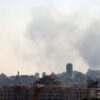When he spoke to lawmakers and in lecture theatres around the world, Mazen al-Hamada’s face told the story of brutal torture by Bashar al-Assad’s regime. The discovery of the Syrian activist’s body inside the notorious Sednaya prison on the outskirts of Damascus brought the news that he never lived to see its downfall.
Hamada’s sunken eyes and haunted face, his tears as he described the depth of horrors he experienced, made him a symbol of the crimes the Assad regime committed against those who spoke out against it.
Hamada was detained and tortured alongside tens of thousands of people after the 2011 uprising against Assad’s rule.
“Mazen had endured torture so cruel, so unimaginable, that his retellings carried an almost otherworldly weight. When he spoke, it was as if he stared into the face of death itself, pleading with the angel of mortality for just a little more time,” wrote Hamada’s friend, the photographer and director Sakir Khader.
He “became one of the most important witnesses against Assad’s regime”, he said.
Details of the industrial scale of detention and torture facilities run by the Syrian state are now surfacing after the overthrow of Assad.
The Syrian network for human rights (SNHR) recorded 15,102 deaths caused by torture in prisons run by the regime between March 2011 and July this year. It said 100,000 more people were missing and thought to be detained, and some might be found now that prison populations have been set free.
Fadel Abdulghany, the head of SNHR, which tracks people who have been “forcibly disappeared”, broke down on live television this week as he said that all 100,000 people had probably “died under torture” in prison.
Hamada was released in 2013 and granted asylum in the Netherlands in 2014, after which he began touring western capitals, bringing audiences to tears as he showed them his scars and described what he had endured at the hands of the Syrian authorities.

In the documentary Syria’s Disappeared he wept on camera as he said: “The law will hold them to account. I will not rest until I take them to court and get justice.”
But, his friends and supporters suggested, Hamada grew overwhelmed by the world’s failure to act. Sara Afshar, who directed Syria’s Disappeared, shared a picture of him receiving a standing ovation for his testimony. “He moved people, and he spoke over and over again. Why did the world not act? Why?” she asked.
Then, in a decision that terrified and confused his friends and rippled through the community of dissident exiles, Hamada disappeared in early 2020 after seemingly deciding to return to Syria.
That someone who had experienced the worst of Syria’s torture chambers would choose to return led many to believe he was enticed to do by elements of Assad’s regime to prevent him from speaking out.
“Assad bears the primary guilt, but the Dutch government is jointly responsible for his death,” said Khader, who believed the Dutch asylum system had failed his friend.
Dutch authorities, he claimed, overlooked Hamada’s suffering and cut off his support. “He saw returning to Damascus as his only option,” Khader said.
The Dutch foreign ministry detailed Hamada’s case, saying he had “returned to Syria” and his whereabouts were unknown, in a report about Syria a year later, but did not comment on what drove him to leave. The Netherlands was one of the countries to announce this week that it would stop processing Syrian asylum and residence applications.
Hamada disappeared soon after arriving in Damascus, amid indications that he had once again been detained by the state. His friends, family and supporters had held out hope that he could be found alive and be able to walk free from the sprawling prison system along with thousands of others.
But the discovery of his body showed that Hamada had died at the hands of those he once escaped, in Sednaya, considered a byword for the cruelty of Assad’s prison systems. The jail has been described by Amnesty International as a “human slaughterhouse”, a place where thousands were tortured, raped, and killed in regular mass executions.
Rebel forces said they found 40 corpses piled in the morgue at Sednaya showing signs of torture, with an image circulating online showing Hamada among them.
The discovery of his body indicated he was probably killed shortly before prison inmates were liberated by insurgents. Khader described his friend’s suffering as “the unimaginable agony of a man who had risen from the dead to fight again, only to be condemned to a slow death in the west”.
This post was originally published on this site be sure to check out more of their content.








